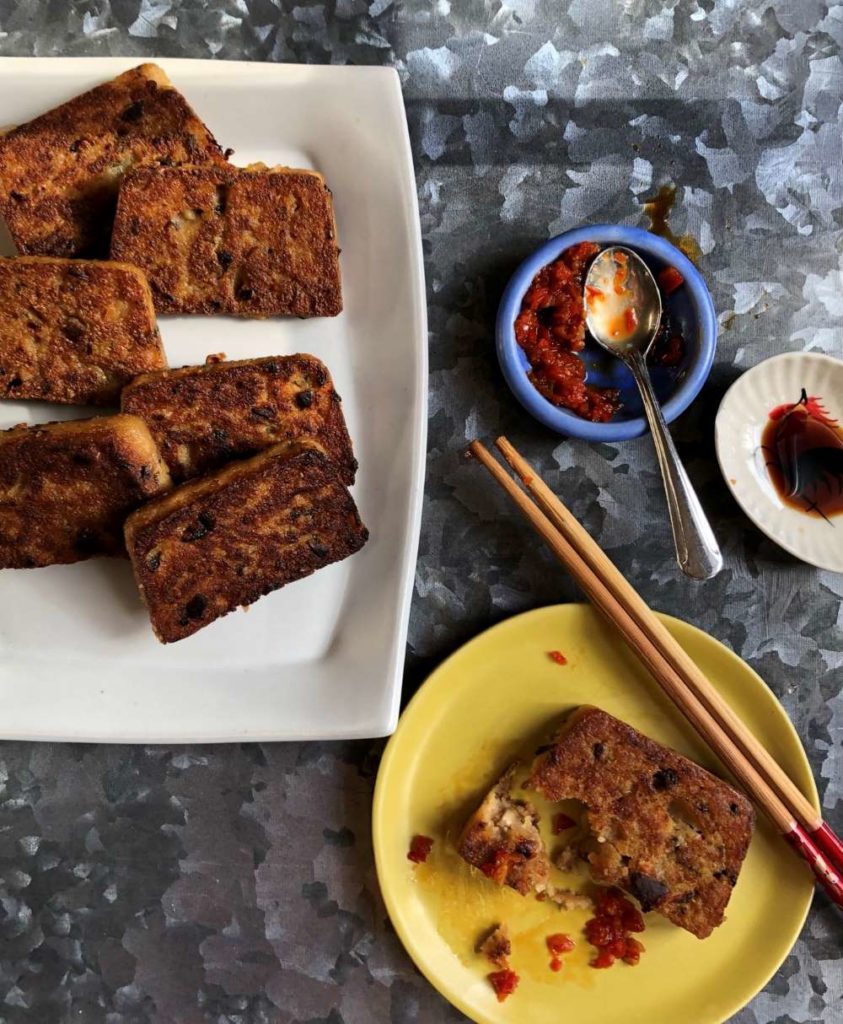
One of my favorite dim sum treats is pan-fried daikon cake. Trouble is, it is seldom crispy enough for my liking. The cooks are under pressure to cook them off for a lot of impatient customers like me so I totally understand. Given that, I've been pondering how to make it super crispy and mostly or all vegetarian. It's not like I have time right now because I'm finishing up a new book manuscript. However, last week, when my dear friend and stylist, Karen Shinto, came for special lunch, I made the excuse to experiment with a new recipe for the cakes.
Daikon cakes are awkwardly called turnip cakes but it's daikon (a kind of radish) that is commonly used. The snack is called lo bak go in Cantonese, luó bo gāo in Mandarin, and bánh củ cải in Vietnamese. The cake is thrice cooked -- a relatively stiff batter is first made in a pot, then it's steamed in a mold or pan, and after chilling, it is sliced and pan-fried. It keeps for days in the fridge, ready to be cut and fried. It is fantastic make-ahead food.
Bits of Chinese sweet sausage, dried shrimp and shiitake usually stud daikon cake. They offer color but more importantly umami. Daikon itself is an umami-ish vegetable so no wonder the cakes are tasty. For this recipe, I decided to go vegetable forward, whole grain, and supermarket friendly. I got what I wanted -- a super crispy, delicious radish cake. Here are some notes for your daikon cake tinkering.
Umami Building Blocks
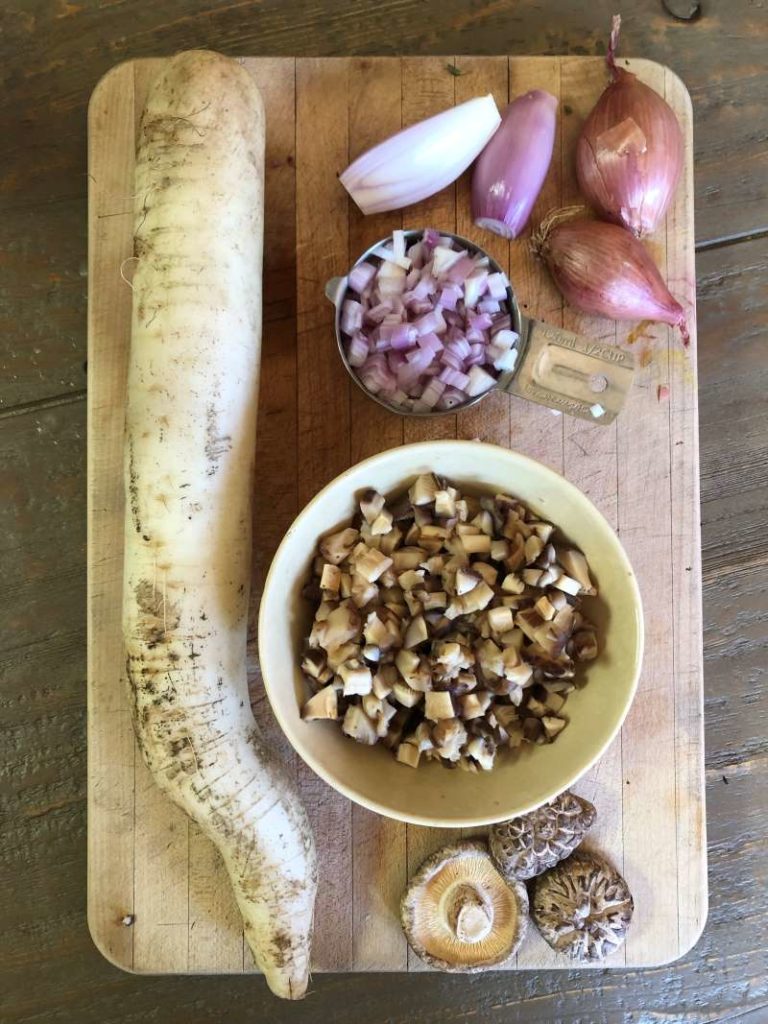
Vegetables have lots of umami and we're not just talking kombu (dried kelp), dried shiitake mushroom, and tomato. Fried onions do too and so does daikon, plus a whole host of vegetables listed on this Japanese website.
Given that, I soaked shiitake mushroom overnight for best flavor and texture, using the soaking liquid for the daikon cake mixture. I also fried up shallot so they are golden and somewhat caramelized. As for the daikon, I used a one-pounder that was sweet. Daikon is sold at many mainstream grocers. I sourced mine from Whole Foods as well as an indie market in our neighborhood. I've seen them sold at Safeway, too. (Daikon selection tip: Make sure its skin is relatively smooth, a sign that it has not struggled much in growing.)
While water is okay to cook the daikon mixture, you're better off with lightly seasoned broth for better flavor. I used vegetable bouillon paste (such as Better than Bouillon) and canned chicken broth on my two rounds. Of course, if you're into chicken broth powder like many Asian cooks, use it instead. I kept things supermarket friendly.
Moisture matters for daikon radish cake
From a recipe that I worked through years ago, I realized that controlling the moisture content in the cake batter was key. You don't want the batter to be too loose or too stiff. If you grate the daikon and squeeze out its liquid to add it to the overall cooking liquid, you can control the moisture level.
Ideally, the cooked daikon radish cake is firm so you can slice it cleanly and easily. At the same time, you want a contrast of crispy exterior and tender interior in the fried cake. Taking this tiny step helps dial things in better. (Clean up tip: Rinse the dishtowel well afterward because daikon can make the cloth musty smelling.)
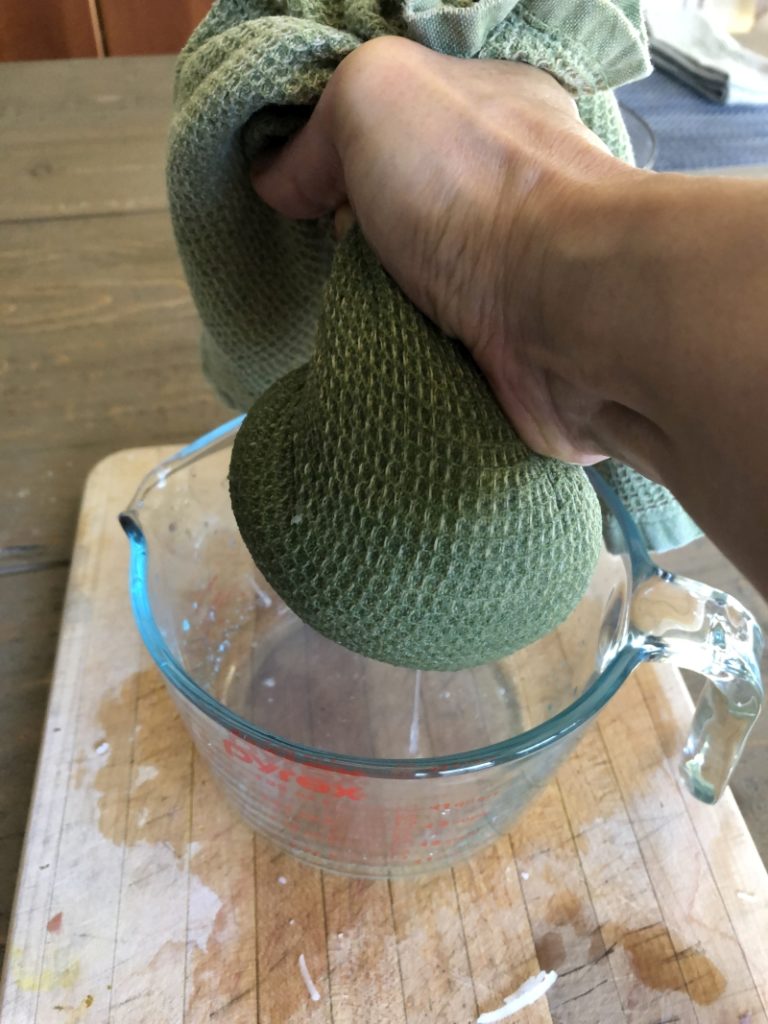
The role of rice flour and starch
To bind the daikon, Asian white rice flour is typically used, its fine texture is rendered by soaking rice and then grinding it, drying the result. Supermarket and health food store rice flour is ground from unsoaked grains so it tends to be coarser. For daikon cakes, supermarket rice flour was fine because I wanted a firm texture. I used brown rice flour by Arrowhead Mills, but you could use white rice flour from the supermarket, if you want more tenderness. Before steaming, the daikon mixture is stiff-ish.
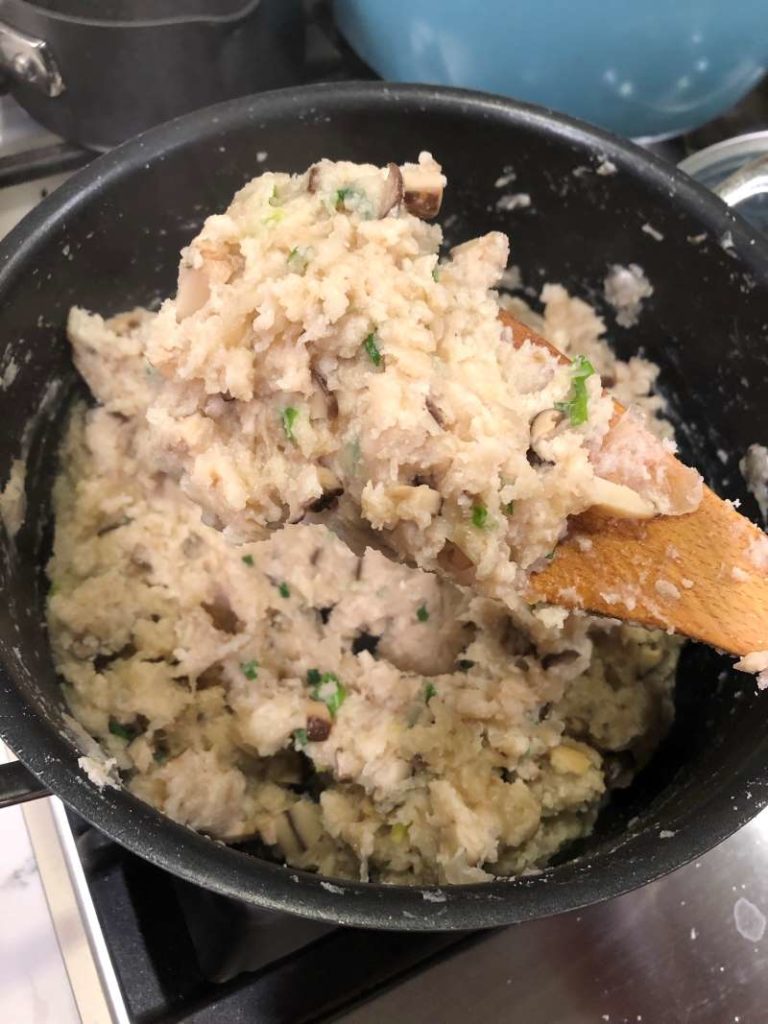
Some daikon cakes use just rice flour and some combine rice flour and a bit of wheat starch. The wheat starch firms things up. I've seen rice flour used with tapioca starch too. But, since I wanted firmness and a crisper than usual fried texture, I chose potato starch and blended it in a 3-to-1 ratio of rice flour to potato starch. Potato starch is denser and fries up firmer than cornstarch or tapioca starch. I used Bob's Red Mill brand, the same as what I used for frying tofu.
What to steam daikon cake in?
These logistics are likely the hardest things to figure out. You need steam action for 45 to 60 minutes. A collapsible steamer will work if it sits in a deep pot so you can hold your daikon rice cake. You just have to replenish water often. Or, use a Chinese steamer. I used my stainless steel metal ones. A bamboo steamer tray set atop a big pot and one of these rings will work well too! What's important is this: the rice cake needs to fit into the steamer set-up.
So, figure out the "mold" for our daikon cake. The amount of daikon cake mixture is 6 cups total and it will expand. In two rounds of daikon cake making, I used Glasslock containers because their rectangular shape were loaf like and easy for slicing. Also, they are heat proof and the lids make for easy storage. One batch fit into the big container, or you could split them among the medium and small containers. Below is a cake steamed in the smallest Glasslock container. It's a cutie.
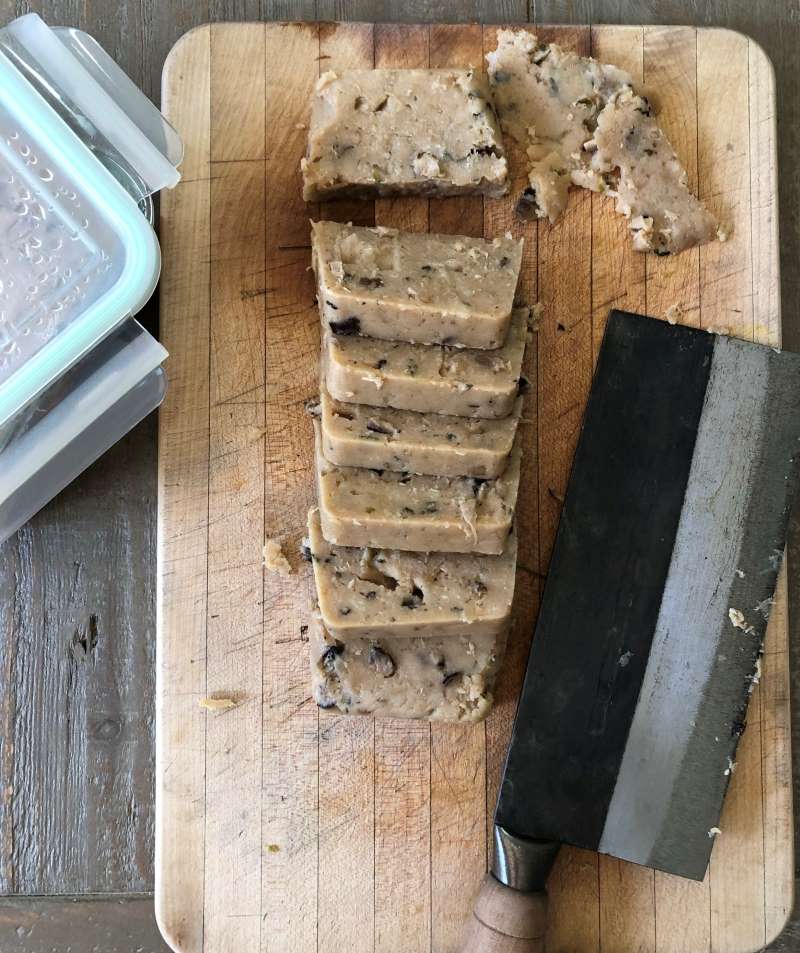
Round containers will work too. So will a metal cake tin or loaf pan. Again, it has to fit into your steamer.
Frying is the fun, easy part. Just slice up what you want to eat and pan-fry the slices. I use a nonstick skillet but you may opt for well seasoned carbon steel or cast iron. The pan-fried slices may be refried but they can get too hard and unpleasant.
I'm happy with this daikon cake recipe and hope you are too. It's supermarket friendly and whole grain. And it fries up to an extra marvelous crispiness. Hooray!
What to serve daikon rice cakes with?
Dumplings are my first inclination. When Karen came over, I made Chiu Chow dumplings from the Asian Dumplings book, plus we had sriracha honey ribs and the smacked cucumber salad from Vietnamese Food Any Day. It was a sensational lunch.
You can check out different dumpling recipes on Vietworldkitchen. A rack of easy Chinese-style ribs would go well with the cakes, as would this zesty red cabbage and cashew salad.
Crispy Daikon Rice Cakes
Equipment
- Steamer
Ingredients
- 1 ¼ ounces dried shiitake mushroom, soaked overnight in 2 cups water
- ½ cup chopped shallot or red onion
- 2 tablespoons canola oil or peanut oil, plus more for pan-frying
- Fine sea salt
- ⅓ cup chopped cilantro leaves and stems
- 1 pound daikon radish
- One 14.5-ounce can chicken broth, or 2 tablespoons vegetable bouillon paste
- 1 teaspoon sugar
- Rounded ¼ teaspoon freshly ground white pepper
- 1 ½ cups (8 ounces) brown rice flour
- ½ cup (3 ounces) potato starch
- Soy sauce or Maggi Seasoning sauce
- Hot sauce, such as chile garlic sauce or sriracha
Instructions
- Gently squeeze the mushrooms to release absorbed water, reserving the soaking water. Finely chop the caps and stems. Set near the stove with the shallot.
- Heat the 2 tablespoons of oil in a medium skillet over medium heat. When barely shimmering, add the shallot and then cook, stirring, for about 5 minutes, until mostly golden and fragrant. Add the mushroom and season with ¼ teaspoon fine sea salt, stir and cook for 1 minutes to develop flavor. Remove from the heat and stir in the cilantro.
- Peel the daikon and use a food processor (or a box grater) to grate the daikon as small as possible. Transfer to a clean kitchen towel. Gather and position it over a large measuring cup, twist to squeeze out as much of the liquid as possible. Dump the daikon into a medium-large (about 3-quart) pot.
- Decant the reserved mushroom soaking liquid into the cup with the daikon water. Add the chicken broth and water to make 3 ½ cups. (Or, add the vegetable bouillon paste and enough water to make 3 ½ cups.) Pour into the pot of daikon and add the ½ teaspoon salt, sugar and pepper. Bring to a boil over high heat, lower the heat to simmer, cover and cook for 5 minutes.
- Meanwhile, put the rice flour and starch in a bowl. Also, you’ll need one or two molds (8 cup capacity total) to cook the cake. It (or they) need to fit into your steamer set-up. Lightly oil the containers.
- Uncover the pot of daikon, and add the shallot, mushroom, and cilantro mixture. Cover and cook for 5 minutes longer. Remove from the heat. Taste and add up to ¼ teaspoon salt for a good savory flavor. Then, in 3 or 4 portions, stir in the rice flour and starch, making sure there’s no visible powderyness between additions. Things will stiffen and lumps are ok.
- Use a spatula to transfer a quarter of daikon cake mixture to the prepared pans, pressing as you go to compact the mixture. Continue adding more of the mixture, pressing to eliminate air pockets. Leave at least ½ inch of space unfilled because the mixture will expand.Steam over boiling water for 45 to 60 minutes, until the mixture rises a bit and a toothpick comes out clean when inserted. Turn off the heat, let cool for 10 minutes before removing to a rack. Partially cover and let cool completely. Cover and chill overnight to easily and cleanly slice.
- Run a knife around the edge and unmold like a cake onto a cutting board. Use a knife to slice a good ½ inch thick. Cut as much as you want to eat, then store the rest uncut. Cut rectangles or squares, whatever you prefer.
- To pan-fry, use a nonstick skillet (choose a size to suit the number of slices you're cooking) and enough oil to thinly film. Heat over medium-high and when shimmering adding the daikon cake slices. Fry for 3 to 4 minutes per side, until crispy and richly browned. Add a drizzle of oil to the pan, as needed. Eat with soy sauce and hot sauce.













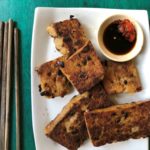




Jocelyn Vande Berg says
Is brown rice powder important for these cakes, or is it alright to use white rice powder? Thanks, they look delicious!
Andrea Nguyen says
I mention somewhere that you can use white rice flour and the result will be more tender. I hope you have great success with your daikon cakes!
Cynthia Robinson says
this recipe sounds great. How close is it to Singapore ‘s hawker “carrot” cake?
Andrea Nguyen says
The exact methods and presentation differ a bit but at core, Singaporean carrot cake is the same as Chinese turnip cake, which is what this is modeled after. Here is information from Atlas Obscura: https://www.atlasobscura.com/foods/carrot-cake-singapore
And, Wikipedia: https://en.wikipedia.org/wiki/Turnip_cake
I hope this helps!
Ray says
Thank you so much for this recipe! I tried to make turnip cake during covid lockdown last year (I was really craving dimsum), but I inadvertently bought brown rice flour and couldn't find any mention of how it would work. Long story short, after steaming in the instant pot I dropped the entire dish on the floor on accident and haven't tried again since. This post gives me hope that I can have success, even with brown rice flour.
Andrea Nguyen says
You're so very welcome, Ray! I've made the same mistake. I'm thrilled that our minds aligned on turnip cake. Hope you enjoy the recipe. Cheers!